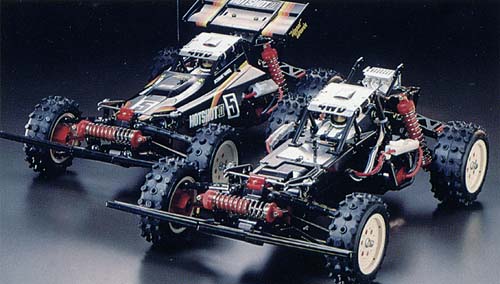Analysis of individual cars
The Hot Shot II (58062)

The HotShot II was kit number 62 from Tamiya. A 1/10 4WD off-road racer, it was a follow up to the successful original Hot Shot.
Specifications
- 1/10 scale on-road car
- 4 wheel drive, center shaft with dogbones at all four wheels
- Plastic tub-chassis
- Fully independent double wishbone suspension
- Coil spring over oil filled monoshock in front and dual shocks in rear
- RS-540 Mabuchi motor
- Off road pin spike/block rubber tires
- Lexan body and rear spoiler
Description
The HotShot II was intended as a followup to the original HotShot to give the chassis a bit more life. The design of the Hotshot II was intended to address some of the shortcomings of the original design while keeping the price low enough to qualify as an entry-level 4 wheel drive buggy.
The complicated metal shocks of the original car were exchanged for simpler and lighter plastic items. While not as rugged as the originals, they provided excellent damping. And for those that have put together the steel ones before, these proved easier for small hands to assemble. Especially when trying to use the pretensioners.
Another area of complaint with the original Hotshot was access to the radio equipment. Whether for adjustments or a simple crystal change the owner had to remove the entire lower chassis to get to it. But with the HotShot II, Tamiya added in a trap door to the top which was closed with a body clip. This door made access to the chassis area much easier and did not require the use of a screw driver.
Changes were also made to the underbelly where the fiberglass piece that kept the battery in place was replaced with a plastic item which offered some side collision protection. Further, the battery was no longer bottom loading. Rather, the owner could insert and remove the battery from the side. This made it much easier to change batteries.
Other changes made were not as impacting to the way the buggy ran. The drive axles were switched for a simple one-piece design, the central drive shaft was a far simpler piece and the complicated aluminum heatsink speed controller was swapped for a more reliable and cheaper ceramic model.
Historical Significance
The Hot Shot II has never enjoyed a huge following. It's simply a better version of the original, but it's place in Tamiya history is not as significant. Collector interest will be limited to those wanting the buggy because they had one as a youth, or because they want the entire 'shot series from Tamiya.
4 wheel drive buggies do better than rear wheel though, so anticipate about $150 for a mint condition unit and $250 for a brand new in box unit.
Additional Notes
Although the car has been discontinued for a long time, the drive train parts are mostly interchangeable with their most popular 4WD models of the time and that means that these parts are all pretty readily available. The only exception being the front gear box case. Because they were prone to crack on impact, these are usually the first parts to run out at the local hobby store. Actually the entire front suspension was prone to rapid wear. Slack in the front arms just gets worse over time and the steering knuckles snap with annoying regularity.
Purists should note the correctness of the parts before purchasing. Because many parts are so interchangeable, owners sometimes substituted parts from the Supershot or Super Sabre in place of the originals for reasons of availability.
Those that choose to run their HotShot should always replace plastic bearings with ball bearings. Tolerances are so important to the long health of the gears in this car. The slop introduced by worn plastic bearings can wreak havoc on your gearbox internals.
Rating
- Collectibility – 5 out of 10
- Fun to drive – 7 out of 10
- Parts availability – 5 out of 10
